Lateral Raise Master Class
Build bigger, wider, rounder shoulders – while also keeping these vulnerable joints safe from injury – by properly executing this classic upper body isolation movement.

Build bigger, wider, rounder shoulders – while also keeping these vulnerable joints safe from injury – by properly executing this classic upper body isolation movement.

The lateral raise – whether done with dumbbells, cables, bands, or on a machine – is one of the best ways to focus on the middle deltoid head of the shoulders. This head gives the shoulders width and roundness.
Yet, to do lateral raises (aka, “laterals” or “side laterals”) in a manner that best targets the middle delts can compromise the supraspinatus muscle of the rotator cuff complex. Likewise, doing lateral raises in a manner that best preserves the rotator cuff will target the front delts, not the middle delts.
With a few modifications, though, you can do lateral raises both safely and effectively. In this Master Class, I’ll teach you how.
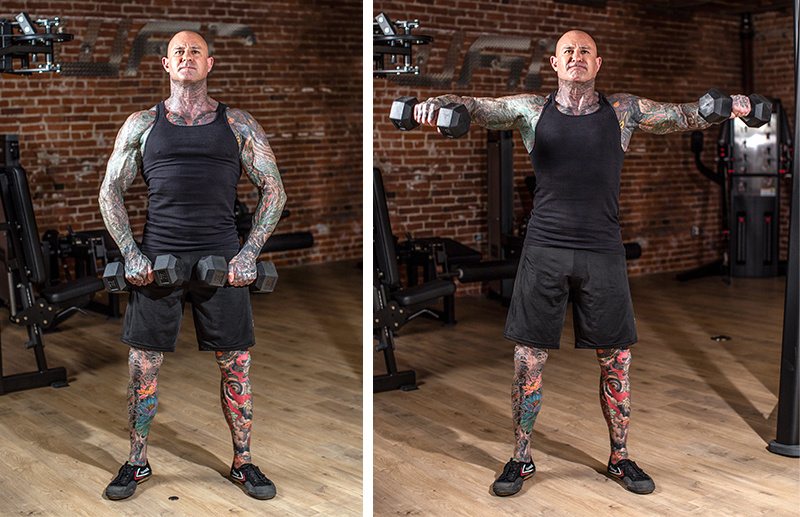
The three deltoid heads of the shoulder include the anterior (front) deltoid, the posterior (rear) deltoid, and the middle deltoid.
The anterior head works to flex the arm at the shoulder – a fancy way to say it raises the arm in front of the body. This deltoid head is best targeted with exercises like front raises.
The middle deltoid head, smack dab in the middle, abducts the arm, which means it raises the arm out to the side. This muscle is best targeted with the lateral raise, the exercise I’m covering in this Master Class.
Last, but definitely not least, is the posterior head. This muscle horizontally abducts the arm, meaning it brings the arm back behind you. The posterior delts are best worked with rear delt raises.
All three heads start from different places on the shoulder complex and converge onto the same tendon that attaches to the humerus (upper arm bone). These three heads work in synchronicity with each other, as well as other muscles of the torso (like the traps and rhomboids) to perform numerous movements with the arm at the shoulder joint.
As I’ve already mentioned, the lateral raise is used to target the middle deltoid head. Bodybuilders, or anyone interested in building more impressive shoulders, are told to do dumbbell lateral raise by holding the dumbbells at their sides with an overhand grip, then maintain the orientation of the hands (palms facing the floor) as the weight is lifted up. This form keeps the middle deltoid on top (facing the ceiling), with the forearms internally rotated, which better targets the muscle as the prime mover.
The problem with this technique, however, is that in the internally rotated position (which is required to keep the palms facing straight down and the middle delts on top), the highest part of the ball and socket jams up into the supraspinatus, one of the rotator cuff muscles. Over time, this can irritate the rotator cuff or even lead to a tear.
To minimize this risk and keep the exercise as safe as possible, there are a couple technique cues to follow…
One way to keep lateral raises safe and stay away from the supraspinatus impingement I just mentioned is to not raise the arms any higher than parallel with the floor. In fact, I recommend stopping just short of parallel at the top to stay on the safe side.
The other safety measure you can take on lateral raises is to keep the arms externally rotated during the movement.
To do this, start the exercise by holding the dumbbells with your palms facing forward – in other words, an underhand grip with the dumbbells in front or at the sides of the thighs. Keeping your palms and forearms facing forward, lift the dumbbells out to the sides until the arms are above parallel with the floor, then slowly lower the dumbbells back to the start position and repeat for reps.
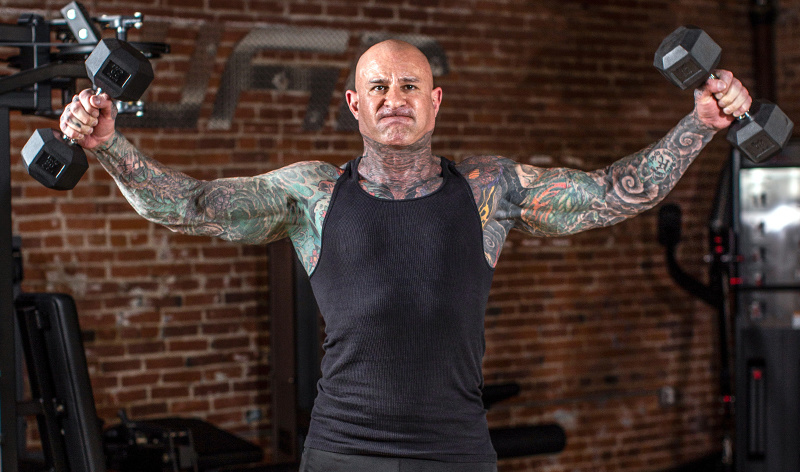
Because this version doesn’t jam the high part of the ball and socket up into the supraspinatus when you raise the arms, you can bring your arms higher than parallel with the floor and still keep the movement safe. Just make sure to go light when using this variation.
The big problem with this version of lateral raises is that, by externally rotating the arms outward, the front deltoid is now on top (above the middle delt as you lift the dumbbells up) and is the primary mover. The middle deltoid head has moved off to the side and is no longer the prime mover.
This version may be safe for the supraspinatus, but it doesn’t work the middle deltoid head effectively.
So how do you keep the lateral raise safe while also targeting the middle delts to build bigger, rounder shoulders? Change your body position to keep the middle deltoid head on top.
This means you need to lean your torso forward. Your best bet is to use an adjustable bench. Set it to a very high position (70-90 degrees) and lean on the bench with your chest and torso so that your head extends off the end. Hold the dumbbells with an underhand grip as they hang directly below you, perpendicular to the floor. Raise the dumbbells up and out to your sides. Hold the top position for a second, then slowly lower the dumbbells back to the start. Repeat for reps in this manner.
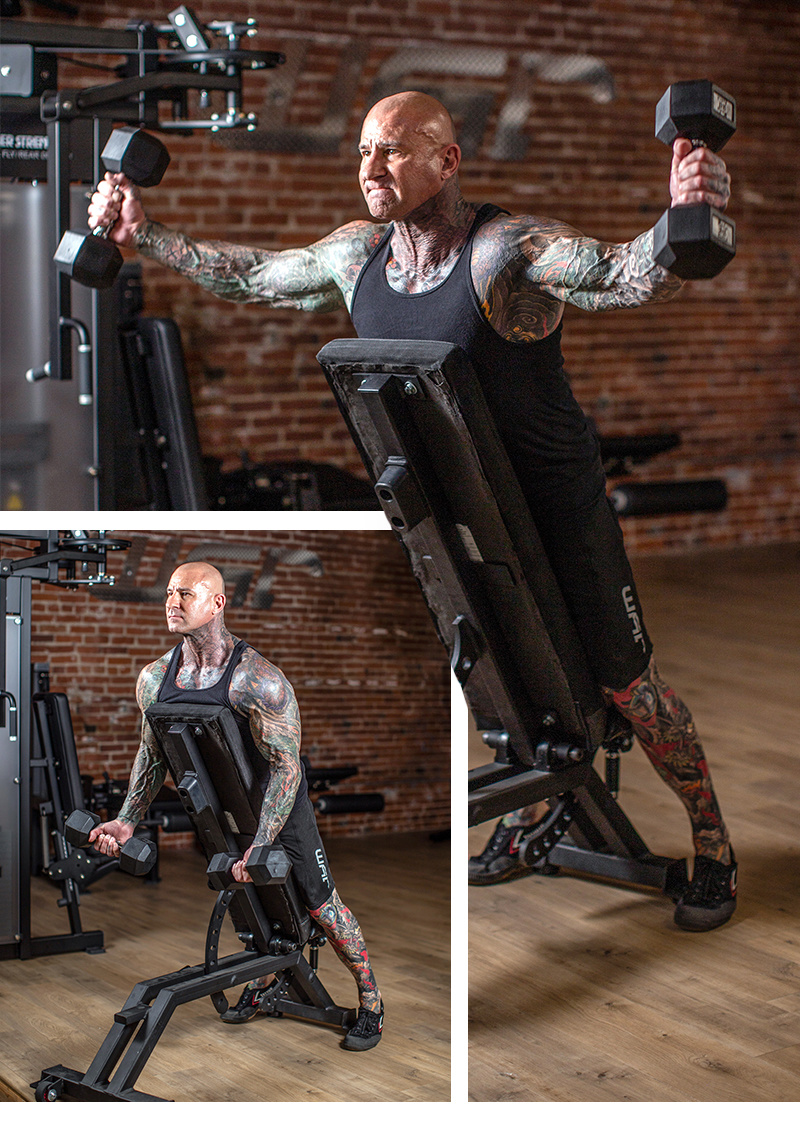
Dumbbell lateral raises are just one variation of the exercise. Cable and band laterals should also be rotated into your shoulder training on a regular basis to change things up and subject your muscles to different types of resistance – namely, the constant tension that both cables and bands provide.
When it comes to doing lateral raises with cables or bands, you can set the line of pull to keep the middle deltoid perpendicular to it, and therefore the prime mover, and still protect the rotator cuff. To do this, set the cable pulley or the tether point of the bands at a point on the floor one or two feet away from you.
With cables, you’ll need to use one arm at a time, unless you have a dual-cable station that allows the pulleys to not only move up and down but also in close to one another.
For the one-arm version in a standard cable crossover station, set the pulley to the lowest setting and attach a D-handle or stirrup handle. Hold the handle with an underhand grip in front of your thigh. Step back from the pulley so that you’re about one or two feet away. Keeping your palm and forearm facing forward, use your middle delt to lift your arm up and out to the side. Hold the top position for a second and contract the middle delts as hard as possible, then slowly lower back to the start position and repeat for reps. Do this for both arms.
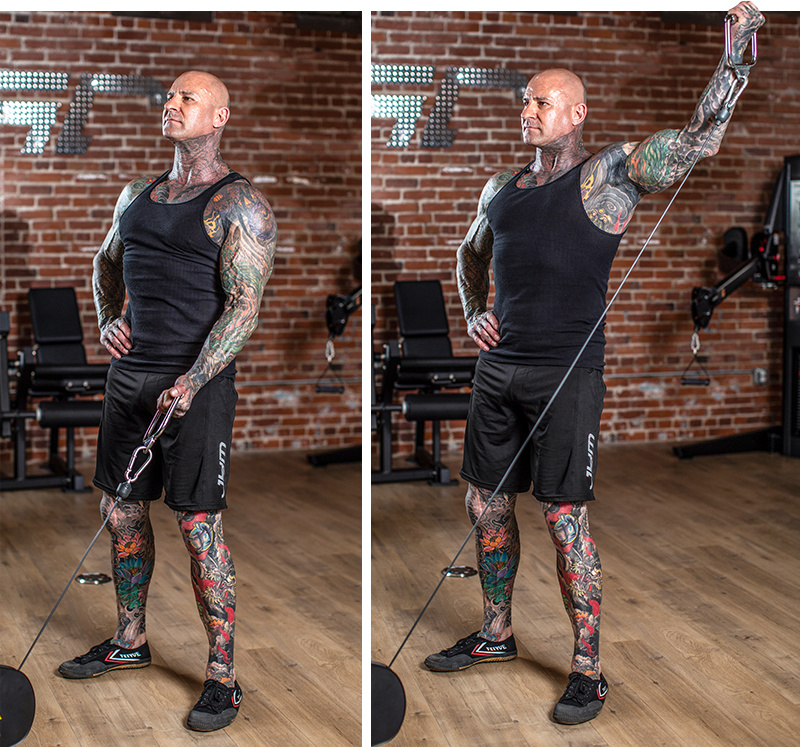
You can also do cable lateral raises with an overhand grip. Hold the handle in front of your thigh, palm facing back. Use your middle deltoid to lift the arm up and slightly back as you extend it out to the side. Try to externally rotate your arm as you raise up so that your thumb is higher than your pinky finger in the top position. Lower back to the start, repeat for reps, then do the same with the other arm.
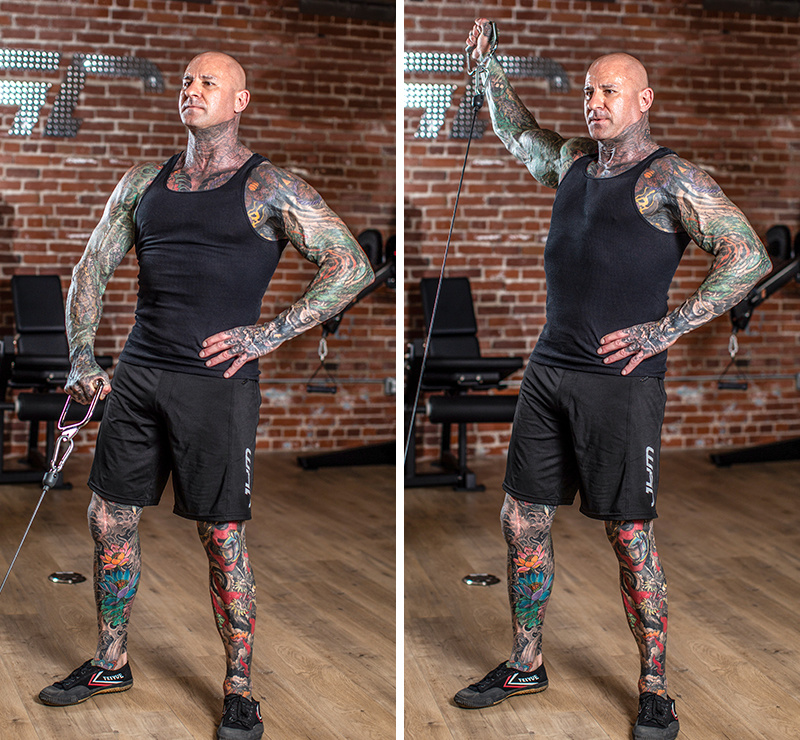
With bands, it’s easier to perform lateral raises two arms at a time. Hold the handles with an underhand grip in front of your thighs, then lift the handles up and out to the sides and contract your delts as hard as you can in the top position, then lower the handles back to the start position and repeat for reps. You can also perform these with an overhand grip in a similar manner to that described above for cables.
Bands are the perfect alternative to dumbbells for one major reason: Due to the linear variable resistance the bands provide, there’s less resistance in the bottom portion of the rep and more resistance in the top. And why is this an ideal situation? Because not only does it maximize the peak contraction at the top, but it also minimizes the focus on the supraspinatus while maximizing middle delt involvement.
The supraspinatus is responsible for initiating the first part of the lateral raise – that first 30 degrees or so of the exercise. The deltoids don’t really kick in until the arms are around halfway up (somewhere between perpendicular and parallel with the floor).
The first half of the range of motion (ROM) is mainly due to the supraspinatus, which is far weaker than the deltoid. Think about when you fatigue on dumbbell lateral raises. Where in the ROM do you cheat the dumbbells up? At the beginning, when your arms are at your sides. And why is that? Because the supraspinatus is the weaker muscle!
And this is what makes bands perfect for lateral raises. The weakest part of the movement is that first part, and that’s also when the bands are providing the least amount of resistance. As you lift your arms up, the bands provide more and more resistance – just as the middle delts are kicking in – to place more focus and overload on the deltoids.
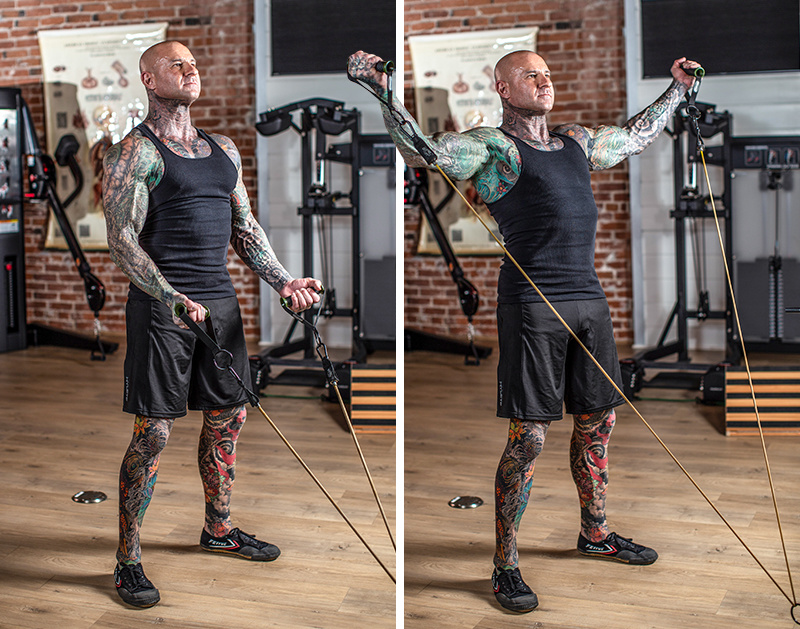
No matter what lateral raise variation you’re doing, or what type of equipment you’re using, one of the most critical technique cues is to pull your shoulder blades back and together. Do this at the beginning of the exercise and maintain this position throughout the set. This makes for a stronger lateral raise movement because the shoulders are stabilized. It also protects the other rotator cuff muscles, like the infraspinatus and teres minor, from getting irritated or torn.
Aside from dumbbell, cable, and band lateral raises, your gym may also have a dedicated lateral raise machine. Is this a good variation to mix into your routine? Absolutely – but with a few technique caveats I want you to keep in mind.
One problem with many lateral raise machines is that they lock you into an internally rotated position at the arms. If you’re stopping short of parallel at the top (which I discussed above), this shouldn’t be a problem and will actually allow you to focus on the middle delts. Yet it’s also good to have the option of external rotation. Another problem with these machines is that you’re not always able to keep your shoulders back and still keep your arms on the pads.
One solution for these issues is to turn around on the machine and face away from the weight stack. Now, you’re not only able to keep your shoulders back, but you can also externally rotate the arms more easily. This external rotation also allows you to safely go past parallel at the top of each rep.
Another option is to face the weight stack but sit far back on the seat and lean slightly forward with the torso. This will also help you keep the shoulders externally rotated, as you’ll see below with my palms facing upward throughout.
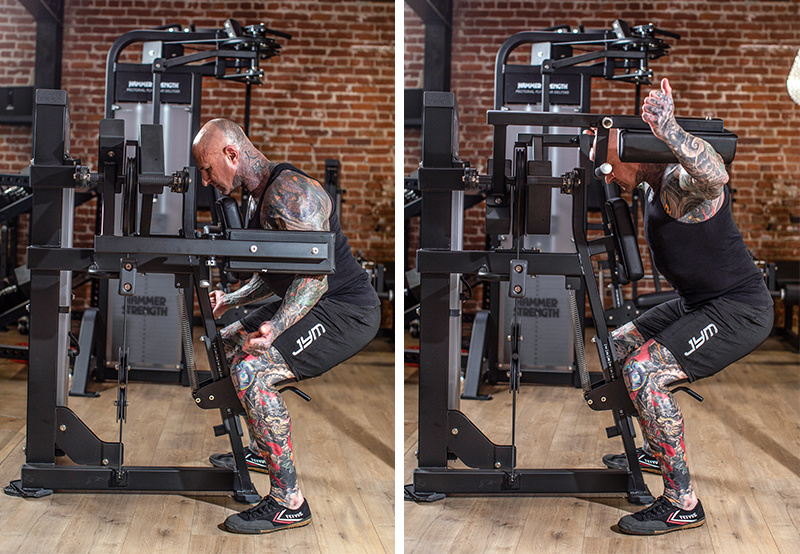
Find this exercise on Day 2 (Legs, Shoulders, Traps, Calves focus) of all six weeks of my 2019 New Year’s Challenge program, not to mention MANY other programs here on JimStoppani.com.
Related Articles